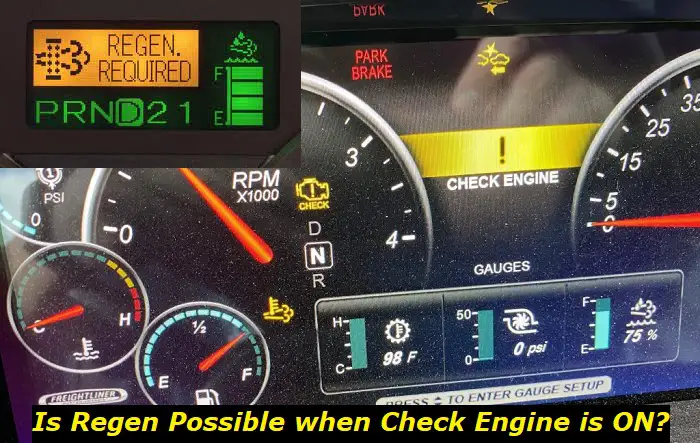Can You Do a Regen with Check Engine Light? Risks and Safeguards
Understanding the functionality of heavy machinery, its intricate components and operational nuances is key for any experienced mechanic; the check engine light and 'Regen' process being paramount among them. A check engine light can illuminate for a multitude of reasons; of which, some are minor, like a loose gas cap, while others might require immediate attention, such as malfunctioning spark plugs or catalytic converter.
Regeneration, or 'Regen' as it is commonly referred, is an automatic cleansing process that removes soot from the Diesel Particulate Filter (DPF) of a diesel engine. This process is necessary to ensure long-term effectiveness and efficiency of the engine. Yet, attempting a Regen when the check engine light is on carries its own risks and dangers. The subsequent parts of this article will delve on whether one can perform a Regen with a check engine light on, the associated dangers, precautionary steps, and expert advice.

What is a Regen and Why is it Necessary?
In the realm of diesel engines, 'Regen' is a common term that refers to Regeneration. At its core, Regen is a self-cleaning process designed to remove soot particles that accumulate in the Diesel Particulate Filter (DPF), a component crucial in controlling the emissions from diesel engines.
Soot builds up in the DPF during the normal operation of the engine and, if left unchecked, can adversely impact the performance of your engine, hinder fuel efficiency, and severely damage the DPF, leading to expensive repairs and downtime. That's where the process of Regeneration comes into play.
During a Regen cycle, the engine computer raises the exhaust gas temperature. This increased temperature helps incinerate the soot trapped in the DPF, effectively cleaning it and allowing the diesel engine to operate at its best. But why is this process so vital?
Well, without regular Regens, there's a high risk of the DPF becoming overly congested with soot. This congestion can lead to increased pressure in the system, causing it to overheat and, in severe cases, fail completely. Thus, for anyone operating heavy machinery, understanding and regularly initiating the Regen process is not just beneficial, but necessary for the overall well-being of their engine.
Can You Perform a Regen with Check Engine Light On
As an expert in heavy machinery mechanics, I cannot stress enough the importance of addressing the check engine light's warning before attempting a Regen. To be direct, while it is technically possible to perform a Regen with a check engine light on, it is not recommended. The check engine light is an indicator of potential malfunctions within your machinery's engine system.
When that light is on, it is a sign that there is an issue with one or more components in your engine. Ignoring it and attempting a Regen might lead to further complications. The issue triggering your check engine light could be directly related to the components involved in a Regen, such as exhaust gases, temperature sensors, or even the Diesel Particulate Filter (DPF) itself.
Allowing a Regen to take place in such circumstances can mask the actual issue at hand, making troubleshooting and diagnosing problematic. What's worse, it could potentially make an existing problem worse or create a new one, resulting in costly damages and repairs.
Therefore, before starting a Regen, it's essential to identify and fix the underlying problem that caused the check engine light to come on. This approach not only ensures the longevity and efficiency of your engine but also keeps your machinery's performance optimal and its operations safe.
Dangers and Risks of Running a Regen with Check Engine Light On
Carrying out a 'Regen' when the check engine light is shining brightly on your dashboard is not advisable. It's akin to ignoring a red flag and having a key piece of information but choosing to brush it aside.
The check engine light is a mechanism designed to alert a driver when something is amiss within the mechanics of their vehicle. If it lights up, it is a definite sign that there are issues that need to be addressed.
Ignoring this warning light and attempting to perform a 'Regen' creates potential risks. The regeneration process, though essential, is intense; it reaches high temperatures to burn off soot collected in the Diesel Particulate Filter (DPF).
Therefore, if there are existing problems within the engine, this process can exacerbate these even further. Problems that might have been insignificant could develop into larger, dangerous issues that compromise the safety of the vehicle and operator, as well as significantly increasing repair costs. It could cause severe damage to your engine, infect the DPF system, and even, worst-case scenario, be a potential fire hazard.
Ignoring the warning presented by the check engine light and proceeding to a 'Regen' may hold dire consequences. Therefore, it's not a gamble worth taking. Address the engine light issue first before proceeding further. Doing so ensures that you attend to your vehicle properly, minimizing risk and preventing expensive damage to your engine.
Steps to Safely Tackle Check Engine Light Before Regen
As an experienced mechanic dealing with heavy machinery, it's important to understand how to handle a lit check engine light before performing a Regen. Prevent further complications and ensure the safety of your engine by taking a structured approach to diagnose and fix the issue causing the check engine light to come on.
The first thing to do is to use a scan tool to read the Diagnostic Trouble Codes (DTCs) from your engine's computer. These codes provide us with key insights into what went wrong in your engine. It's not merely a numeric code. Instead, it's a clue leading to the root cause of the problem with your engine. It could indicate an issue with anything from the engine sensors, emission systems, to the catalytic converter.
Once you have identified the DTCs, it's crucial to research them and understand what they indicate. Industry manuals and online sources provide comprehensive information about each code. If the issue seems minor and well within your expertise, it's perfectly fine to address it yourself. However, if the problem seems beyond your reach, don't hesitate to consult a professional. Remember, a small misstep could lead to a more costly repair or in worst cases, irreparable damage to the engine.
Fixing the issue that triggered the check engine light is a must before running a Regen. It ensures that the issue doesn't interfere with the Regen process, thereby preventing potential damage. Moreover, some vehicles don't allow manual Regen if the check engine light is on to avoid damaging the machinery further.
In the end, once the issue is resolved, erase the DTCs using your scan tool. This will turn off your check engine light and leave your engine ready for a safe and efficient Regen.
Meticulous attention to detail in dealing with check engine light issues ensures the health of your engine and a successful regeneration process.

Add comment